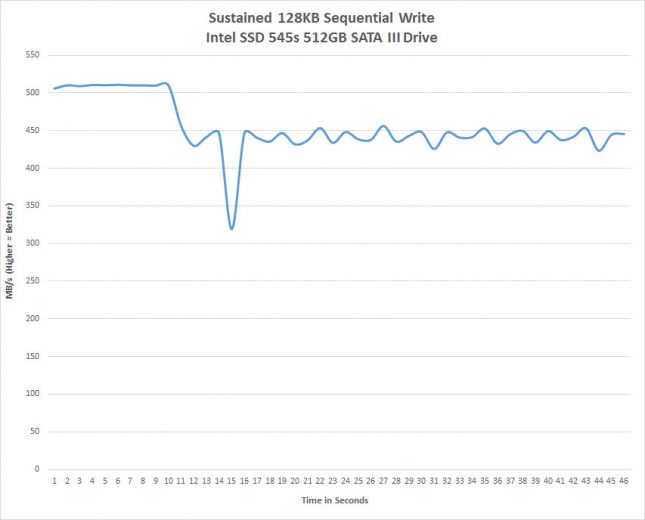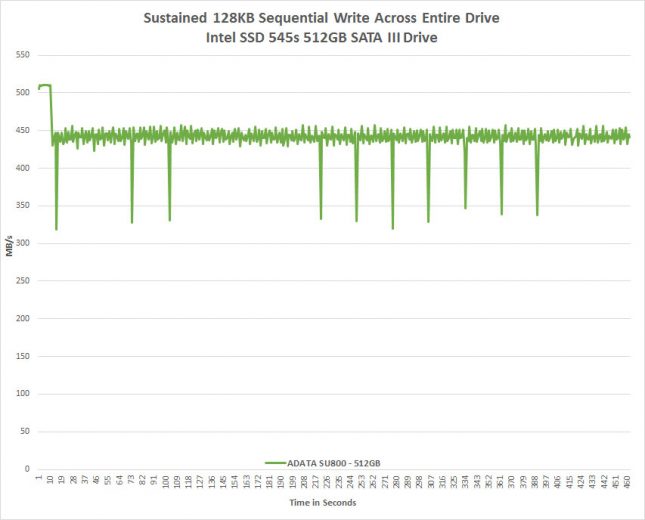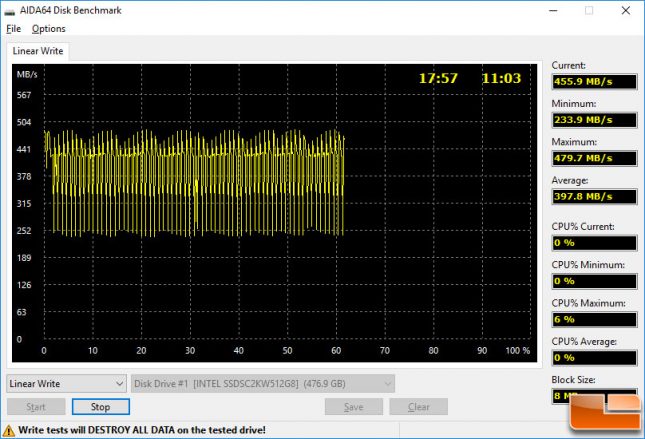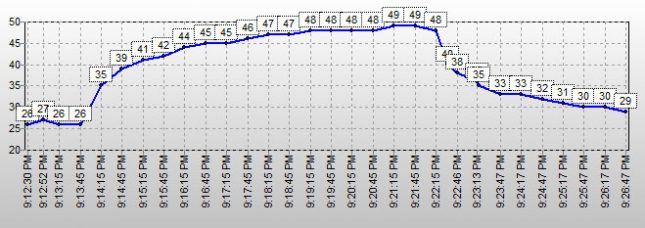Intel SSD 545s 512GB SATA SSD Review – 64-Layer TLC NAND
Sustained Write Performance & Temperatures
Triple-Level Cell TLC NAND based SSDs perform usually quite well, but when you copy a large amount of data to the drive without and idle time you’ll often find a large drop in write speed. TLC NAND is great in applications where write operations are limited , but is usually not recommended for critical systems that have heavy write operations as they have lower endurance ratings than SLC or MLC NAND and of course sustained write performance isn’t stellar. In recent years drive manufactures have been figured out that by using SLC or TLC treated as SLC as a cache they can keep the drives overall write performance high as long as the amount of data being written to the drive fits in the cache. If you overflow the cache, you are then writing directly to the TLC NAND and the write performance will drop down to that level. It should be noted that the SLC cache will clear once the drive idles, so this only impacts long writes that are many GB in size. This might not be a typical workload scenario for this ultra-value or mainstream drives, but still something worth pointing out!
Let’s take a look at the Intel SSD 545s 512GB drive to see how it handles sustained write scenarios with the 3D TLC NAND.
We secure erased the drive before running this test and found that the performance started out at around 506 MB/s and remained around that point for ten seconds. After that point in time the performance dropped the drives write performance down around 440 MB/ after things leveled out with a low of 319 MB/s that happened 15 seconds into the test.
Here are some 45 second average sustained write speeds on recently tested drives:
- MyDigitalSSD BPX 480GB – 1391.78 MB/s
- Corsair Force MP500 480GB – 1369.39 MB/s
- Patriot Hellfire M.2 480GB – 1226.38 MB/s
- Samsung SSD 960 EVO 1TB – 1223.07 MB/s
- ADATA XPG SX8000 512GB – 1197.80 MB/s
- Samsung SSD 850 EVO 500GB 527.23 MB/s
- Crucial MX300 750GB SSD 522.4 MB/s
- ADATA SU800 512GB SSD 520.85 MB/s
- Toshiba OCZ VX500 512GB SSD 520.41 MB/s
- ADATA SU900 Ultimate 512GB – 509.19 MB/s
- WD Black PCIe 512GB SSD – 465.64 MB/s
- Intel SSD 545s 512GB – 454.10 MB/s
- Intel 600p 512GB – 427.295 MB/s
- Toshiba OCZ Trion 150 480GB 347.75 MB/s
- Samsung SSD 960 EVO 250GB – 326.37 MB/s
- WD Blue SSD 1TB 314.81 MB/s
- Kingston UV400 480GB 267.04 MB/s
- OCZ Trion 100 480GB 192.19 MB/s
- ADATA SP550 480GB SSD 103.53 MB/s
Not bad sequential write performance as the Intel SSD 545s 512GB drive finished in the middle of the pack with 454.10 MB/s.
When you take a look at extended sustained write performance over the course of ten minutes that wrote 204 GB of data to the drive. Solid performance from a value oriented SATA SSD, so this drive will take heavy write workloads and write them to the 64-layer TLC NAND just fine.
We’ve had some people as for AIDA64 linear write tests to be done, so we fired that utility up and found that with the standard 8MB block size that the write speeds topped out at 479 MB/s with the lows reaching down to 234 MB/s. The average speed is right around 400 MB/s, so again solid performance is seen for an entry level drive like this.
Intel SSD 545s 512GB SATA SSD Temperatures
A quick look at the drives temperatures showed that we were idling around 26-27C and then hitting 49C during a 10 minute 128kb sequential workload was run. You can see the results below with a 30 second poling rate.
Hitting just shy 50C after performing that many writes is more than acceptable!
Let’s take a look at some common benchmarks!




